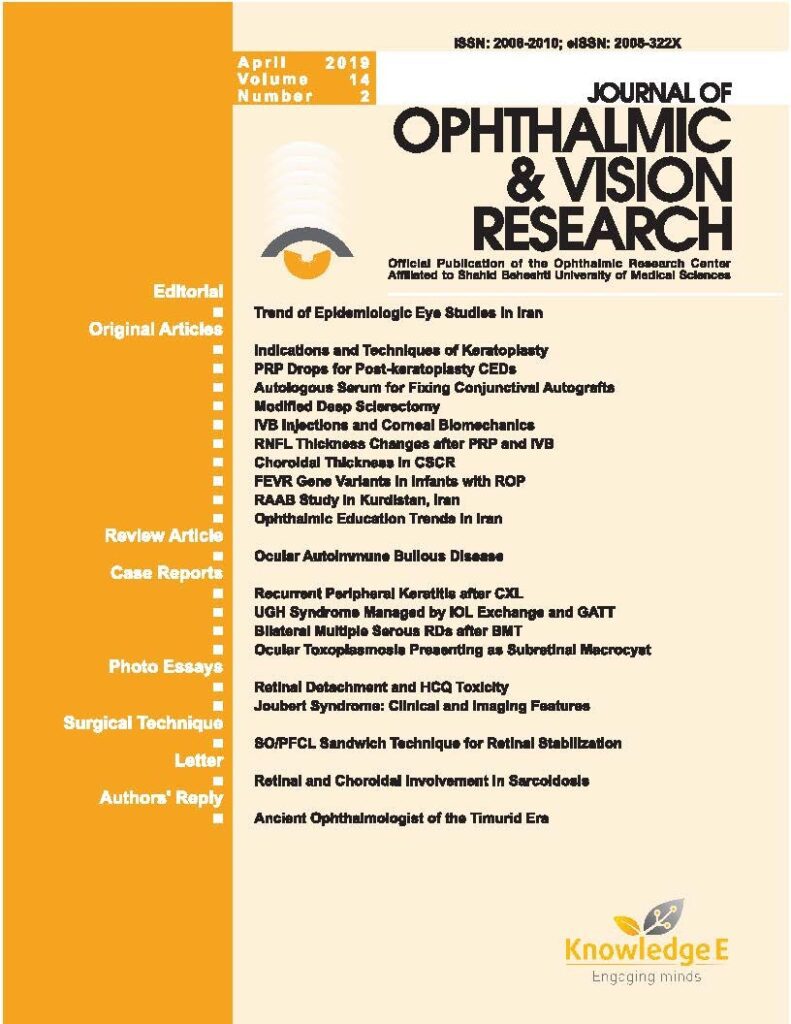
Journal of Ophthalmic and Vision Research
ISSN: 2008-322X
The latest research in clinical ophthalmology and vision science
Diagnostic Performance of the PalmScan VF2000 Virtual Reality Visual Field Analyzer for Identification and Classification of Glaucoma
Published date:Jan 21 2022
Journal Title: Journal of Ophthalmic and Vision Research
Issue title: January–March 2022, Volume 17, Issue 1
Pages:33 - 41
Authors:
Abstract:
Purpose: To evaluate the diagnostic test properties of the Palm Scan VF2000® Virtual Reality Visual Field Analyzer for diagnosis and classification of the severity of glaucoma.
Methods: This study was a prospective cross-sectional analysis of 166 eyes from 97 participants. All of them were examined by the Humphrey® Field Analyzer (used as the gold standard) and the Palm Scan VF 2000® Virtual Reality Visual Field Analyzer on the same day by the same examiner. We estimated the kappa statistic (including 95% confidence interval [CI]) as a measure of agreement between these two methods. The diagnostic test properties were assessed using sensitivity, specificity, positive predictive value (PPV), and negative predictive value (NPV).
Results: The sensitivity, specificity, PPV, and NPV for the Virtual Reality Visual Field Analyzer for the classification of individuals as glaucoma/non-glaucoma was 100%. The general agreement for the classification of glaucoma between these two instruments was 0.63 (95% CI: 0.56–0.78). The agreement for mild glaucoma was 0.76 (95% CI: 0.61–0.92), for moderate glaucoma was 0.37 (0.14–0.60), and for severe glaucoma was 0.70 (95% CI: 0.55–0.85). About 28% of moderate glaucoma cases were misclassified as mild and 17% were misclassified as severe by the virtual reality visual field analyzer. Furthermore, 20% of severe cases were misclassified as moderate by this instrument.
Conclusion: The instrument is 100% sensitive and specific in detection of glaucoma. However, among patients with glaucoma, there is a relatively high proportion of misclassification of severity of glaucoma. Thus, although useful for screening of glaucoma, it cannot replace the Humphrey® Field Analyzer for the clinical management in its current form.
Keywords: Glaucoma, Sensitivity, Specificity, Test Properties, Virtual Reality Perimetry
References:
1. Cook C, Foster P. Epidemiology of glaucoma: what’s new? Can J Ophthalmol 2012;47:223–226.
2. World Health Organization. Blindness and vision impairment [Internet]. WHO; 2019 [cited 2020 February 27]. Available from: https://www.who.int/news-room/factsheets/ detail/blindness-and-visual-impairment.
3. George R, Ve RS, Vijaya L. Glaucoma in India: estimated burden of disease. J Glaucoma 2010;19:391–397.
4. Kulkarni U. Early detection of primary open angle glaucoma: Is it happening? J Clin Diagn Res 2012;6:667– 670.
5. Alencar LM, Medeiros FA. The role of standard automated perimetry and newer functional methods for glaucoma diagnosis and follow-up. Indian J Ophthalmol 2011;59:S53–S58.
6. Wroblewski D, Francis BA, Sadun A, Vakili G, Chopra V. Testing of visual field with virtual reality goggles in manual and visual grasp modes. Biomed Res Int 2014;2014:206082.
7. Tsapakis S, Papaconstantinou D, Diagourtas A, Droutsas K, Andreanos K, Moschos MM, et al. Visual field examination method using virtual reality glasses compared with the Humphrey perimeter. Clin Ophthalmol 2017;11:1431–1443.
8. Kong YX, He M, Crowston JG, Vingrys AJ. A comparison of perimetric results from a tablet perimeter and humphrey field analyzer in glaucoma patients. Transl Vis Sci Technol 2016;5:2.
9. Anderson DR, Drance SM, Schulzer M, Collaborative Normal-Tension Glaucoma Study Group. Natural history of normal-tension glaucoma. Ophthalmology 2001;108:247– 253.
10. Nayak B, Dharwadkar S. Interpretation of autoperimetry. J Clin Ophthalmol Res 2014;2:31–59.
11. Hodapp E, Parrish RI, Anderson D. Clinical decisions in glaucoma. St. Louis, Mo: Mosby; 1993.
12. Cioffi G. Glaucoma. Basic and clinical science course (Book 10). USA: American Academy of Ophthalmology; 2011.
13. McManus JR, Netland PA. Screening for glaucoma: rationale and strategies. Curr Opin Ophthalmol 2013;24:144–149.
14. McHugh ML. Interrater reliability: the kappa statistic. Biochem Med 2012;22:276–282.
15. Brusini P. OCT Glaucoma Staging System: a new method for retinal nerve fiber layer damage classification using spectral-domain OCT. Eye 2018;32:113–119.
16. Mees L, Upadhyaya S, Kumar P, Kotawala S, Haran S, S Rajasekar, et al. Validation of a head mounted virtual reality visual field screening device. J Glaucoma 2020;29:86–91.
17. Wall M, Wild J. Perimetry Update 1998/1999: Repeatability of abnormality and progression in glaucomatous standard and SWAP visual fields. Proceedings of the XIIIth International Perimetric Society Meeting; 1998. Gardone Riveira (BS), Italy: Kugler Publications.
18. Wall M, Woodward KR, Doyle CK, Artes PH. Repeatability of automated perimetry: a comparison between standard automated perimetry with stimulus size III and V, matrix, and motion perimetry. Invest Ophthalmol Vis Sci 2009;50: 974–979.
19. Prea SM, Kong YXG, Mehta A, He M, Crowston JG, Gupta V. Six-month longitudinal comparison of a portable tablet perimeter with the humphrey field analyzer. Am J Ophthalmol 2018;190:9–16.
20. Schulz AM, Graham EC, You Y-Y, Klistorner A, Graham SL. Performance of iPad-based threshold perimetry in glaucoma and controls. Clin Exp Ophthalmol 2018;46:346–355.
21. Ianchulev T, Pham P, Makarov V, Francis B, Minckler D. Peristat: a computer-based perimetry self-test for costeffective population screening of glaucoma. Curr Eye Res 2005;30:1–6.
22. Lowry EA, Hou J, Hennein L, Chang RT, Lin S, J Keenan, et al. Comparison of peristat online perimetry with the humphrey perimetry in a clinic-based setting. Transl Vis Sci Technol 2016;5:4.